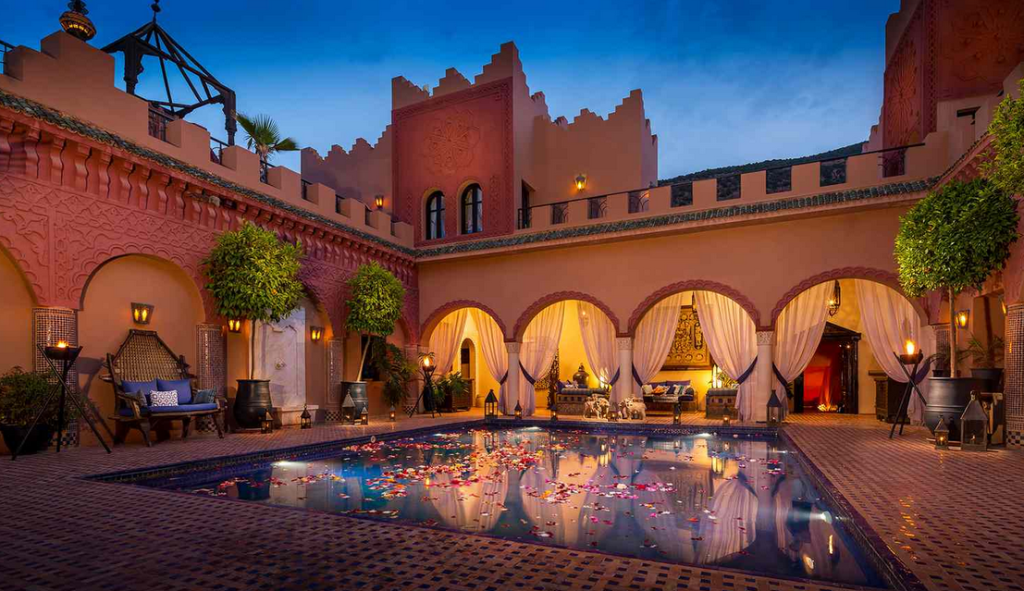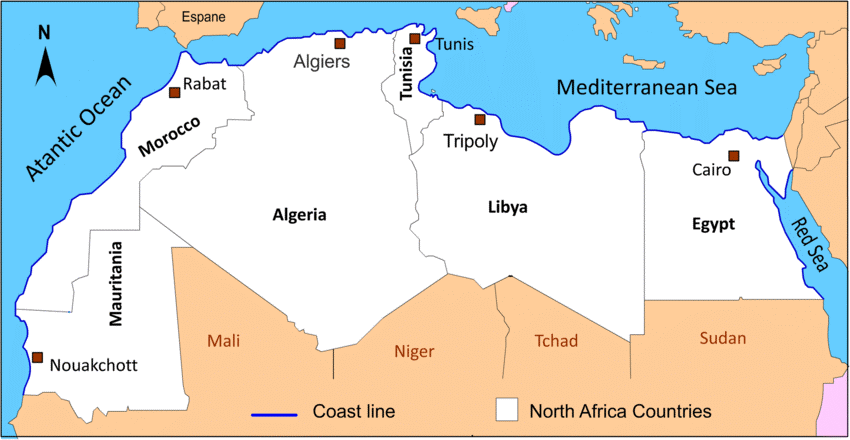The Sahara Desert is the world’s largest hot desert and the third largest desert behind the cold deserts of Antarctica and the Arctic. Occupying nearly 9,200,000 square kilometers, almost as big as the entirety of the United States, it dominates much of North Africa. The Sahara desert spans from the Atlantic Ocean in the west to the Red Sea in the east, covering parts of 11 countries, such as Algeria, Egypt, and Morocco.
The name Sahara comes from the Arabic word for desert, and the English word desert comes from the Latin desertum, referring to uninhabited or forsaken place. True to its name, the Sahara is considered one of the harshest environments on Earth with annual temperatures averaging at 30oC, whilst the hottest temperature ever recorded is 58oC. The area receives little rainfall with half of the Sahara receiving less than 1 inch of rain every year. Despite it being the hottest desert in the world, temperatures tend to drop dramatically at night and can reach lows of -6oC due to the low humidity. Interestingly, the Sahara is much more than just sand as a majority of the desert comprises barren, rocky plateaus, dry valleys, mountains, dunes, and salt flats. All the rivers and streams in the Sahara are seasonal, apart from the River Nile. Additionally, there are over 20 lakes in the Sahara. Lake Chad is the only freshwater lake in the desert, while the others are mostly saltwater lakes. Regular snowfalls can be witnessed on several mountain ranges, but nowhere else in the Sahara.
Top experiences
Despite its inhospitable nature, the Sahara is a playground of limitless possibilities for those seeking the ultimate desert adventure. It is considered a dream destination for adventurers seeking a unique thrill. With its dramatic landscapes, endless dunes, and rich cultural heritage, the Sahara Desert promises unforgettable memories for every travel enthusiast.
Let’s look into some of the most captivating experiences that the Sahara has to offer, making it an ideal and truly magical destination.
1. Camel trekking across the dunes
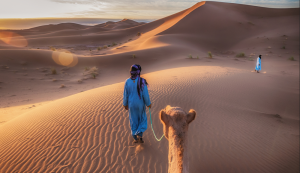
Camels have been the traditional mode of transport across the Sahara for centuries, with a long history of ferrying goods and people across ancient trade routes. Their ability to withstand the harsh conditions of the desert has made them a symbol of endurance. Today, camels offer modern adventurers an opportunity to explore the beauty of the Sahara as they take adventures deep into the desert. So far, several locations across North Africa offer adventurers an opportunity to experience camel trekking. In Morocco, the Chebbi dunes near Merzouga are a popular destination for camel treks, where one can ride through towering orange dunes that stretch as far as the eye can see. In Tunisia, the town of Douz, known as the “Gateway to the Sahara,” is another destination for camel trekking, where one can embark on journeys across the vast dunes of the Grand Erg Oriental. Also, in Egypt, the Great Sand Sea near Siwa Oasis offers a unique opportunity to combine camel trekking with visits to ancient desert settlements and natural springs.
2. Camping
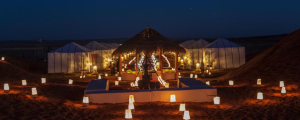
Camping in the Sahara Desert is truly a magical experience that offers travel enthusiasts a unique opportunity to sleep under the starry African sky. With no light pollution, guests get a chance to witness the night sky come to life with a stunning display of stars and constellations as they enjoy a luxurious camping experience with stunning cuisine and accommodation at the campsite. In Morocco’s Erg Chebbi dunes, many guided tours offer overnight stays in traditional Berber camps that are surrounded by towering sand dunes. Campers get to relax in the peaceful solitude of the desert, enjoy local cuisine, and listen to traditional Berber music around a campfire before drifting off to sleep in cozy tents under a canopy of stars. Similarly, Tunisia’s Ksar Ghilane oasis offers another unique location for desert camping, where campers can enjoy both the beauty of the Sahara and the coolness of a nearby hot spring.
3. Cultural encounters with nomadic tribes.
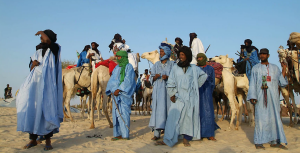
Travel enthusiasts can also get a chance to interact with the nomadic tribes of the Sahara and have a glimpse into a way of life in one of the most challenging environments on earth that has been preserved for centuries. The Tuareg, popularly called the ‘Blue People’ due to their indigo-dyed clothing, are one of the most well-known nomadic groups in the Sahara. The Tuareg have maintained their traditions of camel herding, crafting, and storytelling, and are predominantly found in countries like Niger, Mali, and southern Algeria. Travelers can get to engage with the Tuareg when touring regions such as the Ahaggar Mountains in Algeria or the desert near Timbuktu in Mali. In Morocco, travelers can visit Berber camps, where they can learn about their nomadic lifestyle, experience traditional cuisine, and participate in communal activities such as bread baking or weaving. The Berbers, or Amazigh people, have lived in the desert regions of North Africa for thousands of years, and many still practice traditional lifestyles as nomads, particularly in regions like the Draa Valley and the Erg Chebbi dunes.
4. Discovering ancient ruins and rock art
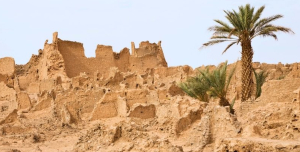
Aside from being a land of natural beauty and cultural diversity, the Sahara is also home to a variety of ancient ruins and prehistoric rock art. These stunning attractions offer visitors a glimpse into the civilizations and cultures that once thrived in this vast landscape. One of the most popular examples is the Tassili n’Ajjer in southern Algeria, a UNESCO World Heritage site renowned for its vast collection of prehistoric rock art. These engravings and paintings date back as far as 12,000 years and depict scenes of daily life, wildlife, and spiritual practices, showcasing the rich history of the region before it became a desert. Similarly, in Libya, the Roman ruins of Leptis Magna stand as a testament to the once-thriving metropolis that connected the Roman Empire to Africa’s interior. These well-preserved ruins include temples, theaters, and monumental arches, giving adventurers the chance to walk through history in the heart of the desert. Also, the Garamantian ruins in the Libyan Fezzan region tell the story of an advanced desert civilization that thrived between 500 BC and 700 AD, characterized by their extensive irrigation systems and fortified cities.
The desert may seem remote and inhospitable, but for those who venture into its depths, it reveals a world full of life, beauty, and endless adventure. So, if you’re seeking a journey that blends thrilling landscapes, cultural immersion, and timeless history, the Sahara awaits.
References
Global Adventure Challenges, (n.d.). Interesting Facts About the Sahara Desert. https://www.globaladventurechallenges.com/journal/facts-about-sahara-desert
Jane, (2024). Camping in the Sahara Desert, AbFabTravels. https://www.abfabtravels.com/camping-in-the-sahara-desert/
Wismayer, H. (2023). It’s been called ‘the greatest museum of prehistoric art’ – but few tourists know it exists. National Geographic. https://www.nationalgeographic.com/travel/article/algeria-rock-art-prehistoric-sahara-petroglyphs
WWN, (2019). North African Nomads – Explained. Walking with Nomads. https://www.walkingwithnomads.com/north-african-nomads-explained/

